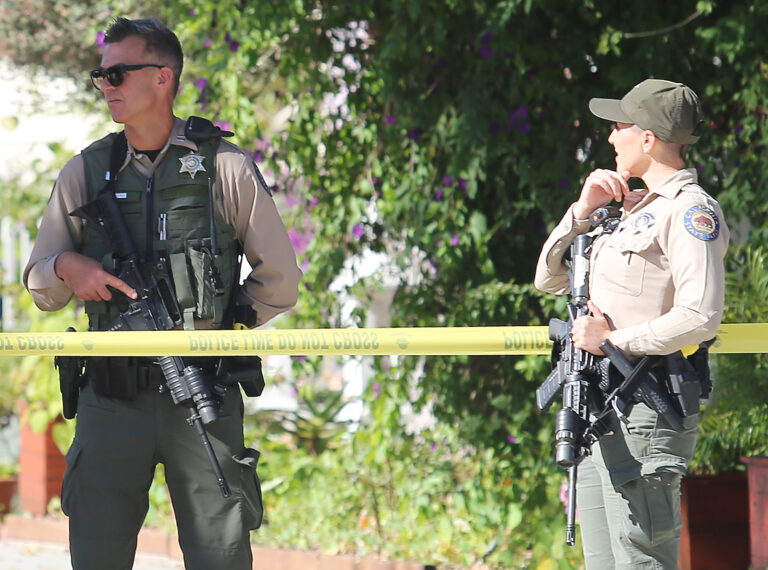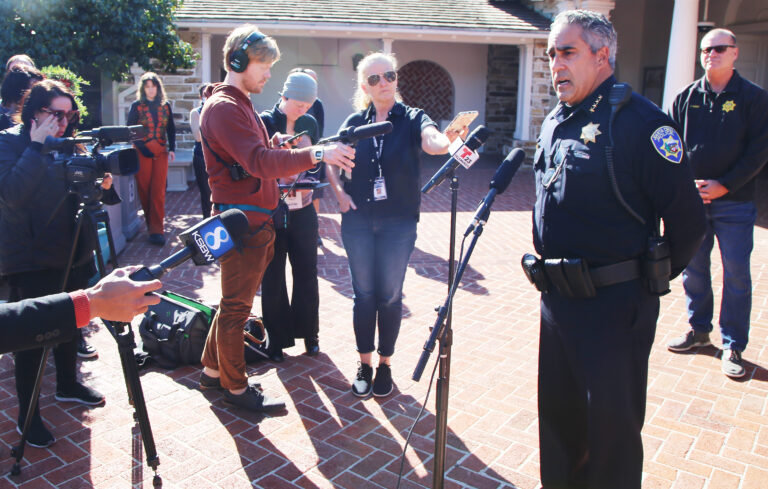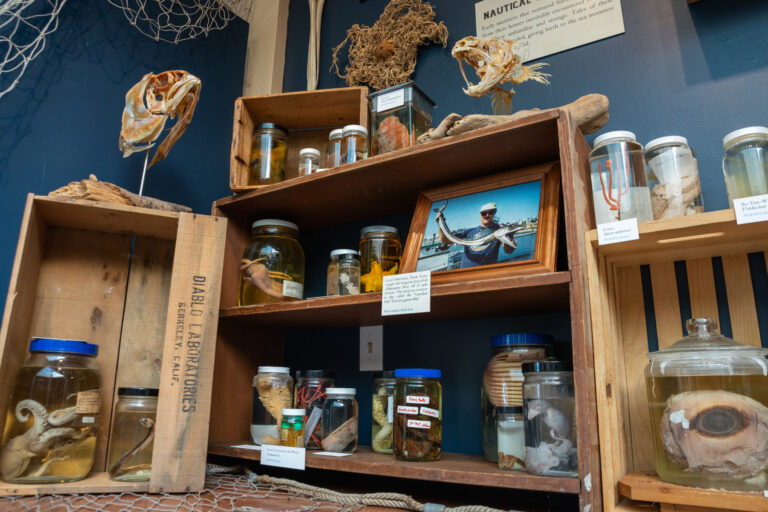Environmentalists and trucking industry groups sparred with clean air regulators today over a contentious proposal to phase out California’s big rigs and other trucks with internal combustion engines, and force manufacturers to speed mass-production of electric trucks.
The California Air Resources Board held its first public hearing on rules that would ban manufacturers from selling any new fossil-fueled medium-duty and heavy-duty trucks by 2040. The new rules would also require large trucking companies to convert their fleets to electric models, buying more over time until all are zero-emission by 2042. The move is part of the state’s wider strategy to end its reliance on fossil fuels and cut planet-warming emissions.
“California is leading the transition to wide-scale electrification of trucks and buses,” said board chair Liane Randolph. “These actions can show the world how to simultaneously address the climate crisis, improve air quality and alleviate key concerns identified by communities.”
The proposed regulation received fiery criticism from both sides, as 167 members of the public lined up to speak at today’s hearing—which started at 9am and lasted well into the night.
Environmentalists and public health groups called for a tougher rule that would speed up the 100% electric truck sales requirement to 2036 instead of 2040, while trucking companies said the proposal ignores concerns about electric vehicle costs and technology, lack of infrastructure and the loss of good-paying jobs.
The Air Resources Board is expected to hold a second hearing on the proposal and vote in the spring.
Jeff Cox, a truck driver of 24 years and owner of the Madera-based trucking company Best Drayage, worries the rule could drive many family-owned fleet operators out of business—especially those with certain types of trucks that the regulation would affect first.
“Obviously we all want cleaner air, but this would be catastrophic to the industry,” he said. “We’re operating in an already challenging environment. To add something else that is this drastic would be very harmful.”
California often leads the country in passing stringent emission reduction standards. The new rule would lead to a transformation of the trucking industry, affecting about 1.8 million trucks on state roads. It builds on other mandates to reduce emissions in the transportation sector, including the gas-powered car ban adopted earlier this year and clean trucks regulation passed in 2020.
But environmental groups often say that while the air board’s regulations on the transportation industry are well-intentioned, they don’t go far enough to reduce the production or use of fossil fuels.
Andrea Vidaurre, a policy analyst at the People’s Collective for Environmental Justice, said the effects of toxic diesel emissions from big rigs and other heavy-duty trucks in heavily polluted communities underscores the need for California to accelerate the transition. Diesel exhaust can lead to several health problems, including asthma and other respiratory illnesses, and increase the risk of hospitalization and premature death, according to air board staff.
“Our communities who are majority immigrant and Black have to deal with higher levels of asthma, respiratory issues, cancers and literally shortened life because of the pollution caused by diesel trucks,” she told the board. “Please use this opportunity to transform this logistics system that historically has done so much harm. Its future doesn’t have to.
“Please strengthen the rule.”
The gradual conversion of existing fleets would apply only to federal agencies and “high-priority fleets,” which are owned or operated by companies with 50 or more trucks or $50 million or more in annual revenue. Also affected: trucks weighing 10,001 pounds or more and package delivery vehicles of 8,500 lbs or more, including U.S. Postal Service, FedEx, UPS and Amazon fleets.
These companies and federal agencies could comply in one of two ways. They could choose to purchase only zero-emission trucks beginning in 2024 while retiring diesel trucks at the end of their useful life, or decide to phase in zero-emission trucks as an increasing percentage of their total fleet. The second option would require starting with 10% of delivery trucks and other types that are the easiest to electrify in 2025, then ramping up to 100% between 2035 and 2042.
The transition to electric trucks for many fleet operators would begin as early as 2024. These trucks have the strictest timeline since they are among the easiest to electrify, including delivery and drayage trucks, which transport cargo at railways and ports in Los Angeles and Long Beach. New models would need to be zero-emission in 2024, while diesel and gas drayage trucks must retire after 18 years.
Drayage trucks are among the most suitable for electrification because they may not need a long range to transport cargo to and from their destinations, and may have more down time for fueling, according to air board staff’s analysis.
But Cox, of Best Dayage, said the rule fails to consider drayage companies with daily haul ranges of 200 to 400 miles that don’t just operate at ports or railyards, such as those that transport goods within the Central Valley. Cox said the high upfront cost of electric trucks and lack of available models also worry drivers, who may not feel confident that the technology can improve before the mandate goes into effect.
“Getting the cart before the horse isn’t going to help matters by forcing the purchase of a vehicle that doesn’t exist today,” he said. “This is both impractical and impossible to comply with.”
Chris Shimoda, a senior vice president at the California Trucking Association, which represents truck drivers, said the heavy weight of electric truck batteries could force trucks to forgo around 8,000 pounds of their load capacity, increasing the need for more trucks and drivers to transport cargo at a time when the industry is already facing a worker shortage.
Enough Chargers and Grid Capacity?
Just 1,943 zero emission medium and heavy duty vehicles are on the state’s roads, and nearly all of them are buses. About 300 are zero-emission commercial trucks, and less than 90 are electric semi-trucks. The rule would add about 510,000 carbon- free medium and heavy-duty vehicles to roads and highways in 2035, increasing to 1.2 million in 2045 and nearly 1.6 million in 2050.
To meet that demand, Shimoda said the state would need to install as many as 800 chargers per week to power truck fleets, representing anywhere from 64 to158 megawatts of new charging capacity, or enough to power 118,000 households.
“We don’t even know that chargers are going to be in place in the next two years to have somewhere to plug in the trucks,” he added. “We can’t even lose time to charging if there’s nowhere to charge.”
Some board members questioned whether the California Public Utilities Commission was prepared to build out the necessary infrastructure and power grid improvements under the proposed timeline.
“This is really a very large undertaking,” said board vice chair Sandra Berg. “I’m trying to understand where the grid problems are going to be and how they can be resolved. How much time do we really need here?”
Air board member Daniel Sperling, who is also the director of the Institute of Transportation Studies at UC Davis, echoed many of the concerns raised by the trucking industry about installing charging stations and making rapid grid improvements.
“I’m having the same whiplash experience that so many fleets have been talking about—the challenges they’re having and getting hooked up to the infrastructure,” he said. “Why are we hearing from these fleets—some of them are saying that they’re not even being given a timeline for when the infrastructure will be in place.”
Yulia Shmidt, an analyst for the Office of Ratepayer Advocates at the California Public Utilities Commission, assured the board that the agency was making significant investments in grid upgrades.
“That is certainly a concern that we are deeply thinking about and that is why we’re looking at the forecast to see where the new load may come from so that we can trigger upgrades in those areas if they’re needed,”she said.
Many truck drivers at the hearing called the proposal unfair due to the high costs of purchasing an electric truck compared to that of a traditional diesel truck.
Air board staff estimate that truck drivers and companies would pay higher upfront vehicle prices now but expect those costs to go down as more models enter the market, eventually bringing the cost down to that of a conventional truck.
When comparing diesel and electric trucks in 2035, staff project that buying and operating an electric semi-truck over its lifespan, for example, could range between $765,000 and $1.1 million compared to a gas or diesel truck, which could cost between $919,000 and $1.2 million. These totals exclude state and federal subsidies that some companies could receive to help them pay for a truck.
Staff also said lower maintenance and operational costs would save fleet operators money over time.
Though trucks represent just 2 million of the 30 million registered vehicles in the state, they are the largest single source of air pollution from vehicles. Heavy-duty trucks spew 70% of the state’s smog-forming gases and 80% of carcinogenic diesel pollutants, according to the air board.
Air board member and Democratic state Sen. Connie Leyva of Chino acknowledged the disproportionate air pollution toll many communities have faced and the state’s role in that inequity.
“This is probably a little inappropriate, but my takeaway was that we do bad shit to poor people,” she said. “Most of what’s happening is happening in poor areas of the state.”
Sam Wilson, a senior vehicles analyst with the Union of Concerned Scientists, a science advocacy organization, said the air board needs to tighten the rule to get more emission reductions from the most polluting trucks to avoid the damaging effects of diesel exhaust.
Speeding Up Rules for Big Trucks?
The proposal has different deadlines for phasing in new sales of electric models, varying based on the size and type of truck, until all are electric by 2042. In addition, the requirements for converting fleets would not apply to smaller companies that operate less than 50 trucks, unless they were using a larger company’s trucks. They could keep their trucks as long as they want under the proposal, although their new purchases would have to be zero-emission by 2040.
Wilson said the requirement for fleet operators who manage some of the largest and most polluting trucks—such as long-haulers, big-rigs and semis—should be put on a faster electrification timeline, with a phase-in starting date in 2027 rather than 2030.
He also said the proposal threshold of 50 trucks should be lowered to 10 trucks for these fleet operators, given the outsized role large trucks have in emitting deadly soot pollution. A fleet of 10 tractor trucks emits about three times as much nitrogen oxide—a smog-forming pollutant—and about the same amount of fine particulate pollution as a fleet of 50 delivery vans, according to air board staff’s estimates.
“There’s a difference in the amount of pollution that is emitted between a plumbing company that has 50 vans, for example, and a hauling company that has 50 tractor trucks,” he said. “In order to account for this, a fleet of tractor trucks should have a compliance threshold of 10 rather than 50 just to account for the extremely disproportionate impact that they have.”
Randolph, the board chair, said it would be “counterproductive” to pursue some actions that environmentalists were calling for, including reducing the fleet size or moving up timelines for some truck classifications, suggesting that it “might create more burden than is necessary” for the trucking industry. She did, however, support the idea of moving up the manufacturer production timeline, which many board members also agreed with. The board directed staff to assess that possibility and other changes to the rule to address charging, grid and vehicle availability challenges.
“We as a board should discuss the possibility of an earlier 100% sales to 2036 and really push manufacturers to step up and make these vehicles available,” she added
Other States Set to Follow?
A coalition of representatives from several states, including New York, Washington, Wisconsin and Connecticut, urged the board to adopt the rule and said they would move to implement it in their states too.
“The board’s approval of the advanced clean fleet regulations will enable New York and other states to adopt those regulations to support the needed transition to zero emission transportation and cleaner, healthier communities,” said Jared Snyder, the deputy commissioner for Air Resources, Climate Change and Energy at the New York State Department of Environmental Conservation.
Although California legislators have no direct say over whether the board adopts the rule, dozens of lawmakers weighed in on the proposal—and vastly disagreed about it.
In a letter to the air board, a group of state legislators, including Democratic Sens. Nancy Skinner of Berkeley and Josh Becker of Menlo Park, and Assemblymember Cristina Garcia of Bell Gardens, agreed with environmentalists. They note that these changes are achievable due to this year’s massive $54 billion climate investment, which includes $10 billion in state funding to rapidly deploy electric vehicles and charging stations.
The climate package allocates billions for electrifying medium- and heavy-duty trucks, including $1.1 billion for zero-emission trucks, buses, off-road equipment and fueling infrastructure and $400 million for charging stations at ports. Truck drivers and companies could receive additional benefits through the federal Inflation Reduction Act, which includes a 30% tax credit for zero-emission commercial vehicles and charging stations.
But in a separate statement, some legislators including Democratic Assemblymembers Blanca Rubio of Baldwin Park, Carlos Villapudua of Stockton and Rudy Salas of Bakersfield—especially those from rural areas or with high concentrations of fleet operators in their districts—sided with the trucking industry, saying the proposal is too “aggressive” and places many financial burdens on fleet operators. They also said the plan fails to address many technical challenges, such as the toll electric trucks will have on the grid as power demand grows, and the fast-charging needs of heavy-duty rental vehicles like water and dump trucks that operate in remote locations.






























